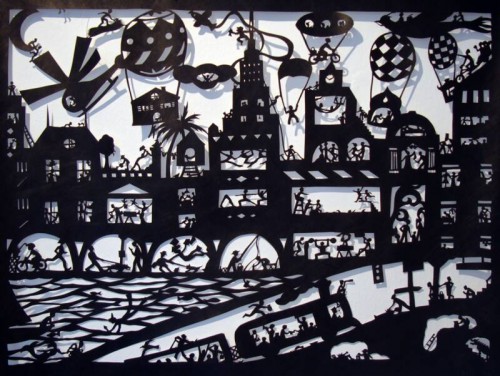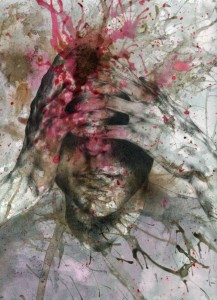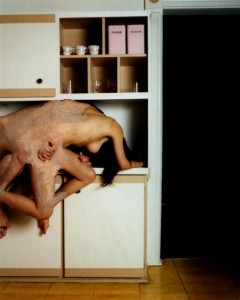Behind the Scenes
Interview with Angela Leroux-Lindsey of The Adirondack Review
I’ve always been curious about the darkroom where literary magazines come together. This is a series of interviews engaging, talking, and sometimes annoying editors about their magazines. How did they come about, what do they hate about editing, and what do they love most about it? This is the first in the series and I talked with Angela Leroux-Lindsey of The Adirondack Review. The visual imagery is simply stunning. The Adirondack Review is like an art gallery curated online, constantly evolving, fused together with great stories, poetry, and essays. In preparation for the interview, I pretty much went through the entire archives and got a brain dump, Matrix-style, in art and photography. A jolt to the system is what I like feeling with my lit magazines and reading directly from their about page: “The Adirondack Review is an independent online quarterly magazine of literature and the arts dedicated to publishing poetry, fiction, artwork, and photography, as well as interviews, articles, book reviews, and translations. Recently named a ‘great online literary magazine’ by Esquire and a ‘top online journal’ by The Huffington Post, TAR was established in the spring of 2000, with its first issue appearing that summer.”
As a brief bio and introduction to Angela Leroux-Lindsey:
Angela Leroux-Lindsey is editor of The Adirondack Review and senior editor with Black Lawrence Press. She writes for Kirkus Reviews and A&U Magazine, and has contributed essays and stories to phys.org, Animal Farm, Innovation Magazine, NY Metro, Brookhaven National Laboratory, and others. She lives in Brooklyn.
***
PTL: Can you tell us about the review, how did The Adirondack Review first get its inception and how did you first get involved?
Angela Leroux-Lindsey: The magazine has actually been around since the summer of 2000—the founder editor, Colleen Ryor, was sort of a pioneer in never going to print, which is something I’ve always admired. But I didn’t start contributing until 2006 or 2007. At that point Diane Goettel was editing, and when she left to run Black Lawrence Press full-time, I took over. So my first issue was in the winter of 2009. A big part of the appeal was their early commitment to publishing art. I especially love how being online gives us the freedom to publish as much full-color art as we want; in the fall issue, I featured almost 30 images by five different artists and photographers. This is something we could never afford if we had to pay for ink and paper. We also publish poetry, fiction, and works in translation in every issue, a mix of mediums that I think is really lovely. Every time we close I’m sort of delighted to see unexpected threads emerge that tie completely different submissions together: a drawing that evokes the tension of post-apocalyptic familial relationships next to a story that takes place on a placid lake over the course of an afternoon but is really about survival. Discovering these entanglements and bringing so many different people together is so much fun. It’s the best job.
PTL: Each issue is packed with fiction, poetry, and some of the most incredible photography and art I’ve seen. What goes into the curating and selection process?
ALL: Well, like every small lit mag out there, I rely so much on my staff. We all volunteer, which makes it even more amazing that I’ve found a group of people willing to be so thoughtful and imaginative about how we compose issues. Nick Samaras, our poetry editor, came on board when I did and he’s brilliant. Google him, read his poetry, you’ll just swoon over it.
Regarding art, some of it comes in through the submission process, but a lot of it I solicit. Sometimes I’m just scrolling through tumblr and come across a piece that floors me. And I’m always completely thrilled when a big name that I’ve solicited says yes: I mean, Manfred Mohr was on the cover of the summer issue. I was watching some of his animated videos from the 70s on YouTube, and figured I’d send him an email to ask if he’d be interested in featuring some of his new stuff. And he emailed me back within a week and said yes. I’m still excited every time this happens. It’s magical. Richard Mosse is another example. I’m in love with his INFRA series, which is online now.
Really, getting to work with all of these artists and writers is absolutely the best part of having this role. Not just meeting new people and developing friendships—like with you, Peter—which I really value. But living in Brooklyn and getting to hang out with so many writers I admire is killer. You wouldn’t believe the people I’ve met and fallen completely to pieces in front of. I hosted a reading once with Paul Muldoon and could hardly pronounce my own name when I introduced myself. And then to watch emerging writers and artists who have published work with us go on to publish books or exhibit work at major galleries or museums is really awesome. My friend Kit Frick has a completely gorgeous chapbook coming out called Echo, Echo, Light from Slope Editions. We published early versions of a few of these poems in 2011 and I can’t wait to see how they’re incorporated into a collection. And Luba Lukova, a political artist whose work I sought out for the cover of the first issue I edited, will show at MoMA next month. Revisiting these issues and experiencing that kind of folding of time is a cool thing. It makes me think of the larger view of independent publishing as a sort of performance art space in itself.
PTL: The summer issue has a lot of stories that began with a wallop, from Garrett Quinn’s “Fighting, Chewing, Shooting with: “Where’s that little shit, Anton?” Ollie shouted, bursting into the barn,” to “E.J. Floyd didn’t put a bullet in his head.” How important is the first sentence when it comes to making choices on submissions?
ALL: You know, I hate to make a blanket statement about any part of the selection process, but it is important. There are so many exciting journals publishing online, and so much of it is awesome. We know it’s tough to get people to visit our site, to look around, to read an entire story. We want to make sure we catch your attention. So it makes that first sentence a bit more paramount than it should be, I think. And I struggle with this myself: sometimes I think I come up with a really sublime way to begin a story, only to realize once it’s done that it’s awful. It’s so boring. The first sentence should really get the reader in a specific frame of mind. The writer knows where the characters are going, how the tension develops, but obviously the reader will have no expectations. So we try to think about that when we select stories to publish. But I’ll be honest: we tend to publish the stuff we love the most, even if this opening-sentence thing doesn’t apply exactly.
PTL: I love the quote on the About Page: “When people tell me of the exotic trips they have taken across the country, or around the world, some of which I have had the good fortune to take as well, it is always to the Adirondacks that my heart returns.” How important is geography to The Adirondack Review?
ALL: I think we ground our aesthetic in geography all the time. Our relationship to the Adirondacks, in particular, is something that may not be as strong as it was ten years ago—when Colleen was actually living there—but I try to maintain the commitment to nature, to the wonder of the natural world, from a more global perspective. I love to publish artists and writers who find inspiration in the connections between humans and non-humans. Whether it’s an image of star tracks above a village in Chile or cliffside bee colonies in India, that moment of interaction, of capture, is profound. I fall in love with things so easily, and we want to convey this to our readers. Art, obviously, is not limited to a geography, and we’re lucky that because we’re online, people can access our magazine from anywhere in the world for free. We’ve never charged for subscriptions or sold ad space. So to broaden the originating philosophy and yet retain its aesthetic core is sort of where I’m at right now, I think.
PTL: Do you notice any trends in the types of submissions you receive and are there any types of submissions you especially love seeing?
ALL: I love seeing that more and more writers are submitting weird, wacky stuff. To me that’s the best. Just writing that is on the border of making no sense, but then after you’ve read it, somehow it settles in your gut and you love it so hard and it’s so gorgeous. Our selection process is a democratic one—just because this is the stuff I love the most doesn’t mean that’s all we pick. But I’m lucky and I think most of time we agree. One of my favorite stories ever was selected by another editor, it’s called Delilah and Max in Paradise, in the summer issue. It’s so good.
PTL: In the submissions section, it’s mentioned the delight in finding unpublished talent. Any writers, poets, or artists you would especially like to mention?
ALL: I love working with people who haven’t been published before. In the summer issue we ran a series of photos by a photographer named Gary Schroeder. He actually does all the web design at the Brookhaven Lab, a particle collider in New York, where I spent some time during grad school. So I first knew him as having a really linear way of looking at things, and then it turns out that he’s been photographing the lab for years, and created a really dreamy, romantic photo essay about nuclear science. I mean, I’d probably never turn down the opportunity to publish bubble chamber images, but still. It took me about three seconds to ask him if I could feature them. I love meeting people like this, finding out what they’re up to, and including them in an issue. You’d be surprised how many people have secret talents.
PTL: I love the Color Project, but in your own words, can you tell us about it?
ALL: Thank you! A Color Project is such a simple joy, I think: it’s just a space online, on tumblr, where people can submit their photography to match the current month’s color. Each month I pick a new Pantone card, which is so much fun in itself, plotting the color sequence, trying to predict what people will submit. July was gray and we got all of these great photos of cement and storm clouds. Now that we’re six months in, a really pretty collective is starting to form. The archives are fun to look at. And it’s again embracing this idea that art—and color—are at once culturally specific and geographically universal. Red means something totally different in Africa than it does in the United States. Red is a symbol of mourning there. But it’s also like, a gray cement wall in Brooklyn is a gray cement wall in Iraq. Color abbreviates boundaries in a way that is very easy. I love it. And I have plans for the next phase, maybe even two phases of this project. So stay tuned.
PTL: Are there any aspects of editing you don’t like?
ALL: This is so unoriginal, but I hate sending rejections. I know how that feels. It sucks. I really respect how much effort goes into each submission. And we get so much great stuff, and I wish I could say yes to a lot more of it. But I’ve really committed to not inundating readers when they visit our site, to not having each issue be an overwhelming experience. And like I said before, there are so many other literary magazines out there that I admire, that are publishing such fantastic work. I want to complement them, to find a comfortable place within the field, to not try to do everything all at once. It’s tough though. A lot of submissions come really close, and we’d love to say yes to more things.
PTL: In terms of your personal writing, are you working on anything at the moment?
ALL: I just finished grad school, and didn’t write much except research papers for probably three years. I’m starting to work on some stuff, a collection of stories based on Daumal’s pataphysical essays. It’s a trip. So maybe if you ask me again in a year I’ll have a more exciting answer.
PTL: Millions of years from, when an alien species discover the remains of Earth and downloads the archives of the Adirondack Review, what would you like them to say about it?
ALL: Good question! I guess I hope aliens will look at the archives and say something like “the currency of the human race must have been imagination.”
***
Peter Tieryas Liu is the author of Watering Heaven (Signal 8 Press, 2012) and Bald New World (Perfect Edge Books, forthcoming). He has work published in places like the Evergreen Review, Indiana Review, New Letters, and ZYZZYVA. He rambles about his bad literary habits at tieryas.wordpress.com
Tags: Adirondack Review, Angela Leroux-Lindsey, Peter Tieryas Liu




[…] http://htmlgiant.com/behind-the-scenes/interview-with-angela-leroux-lindsey-of-the-adirondack-review… […]